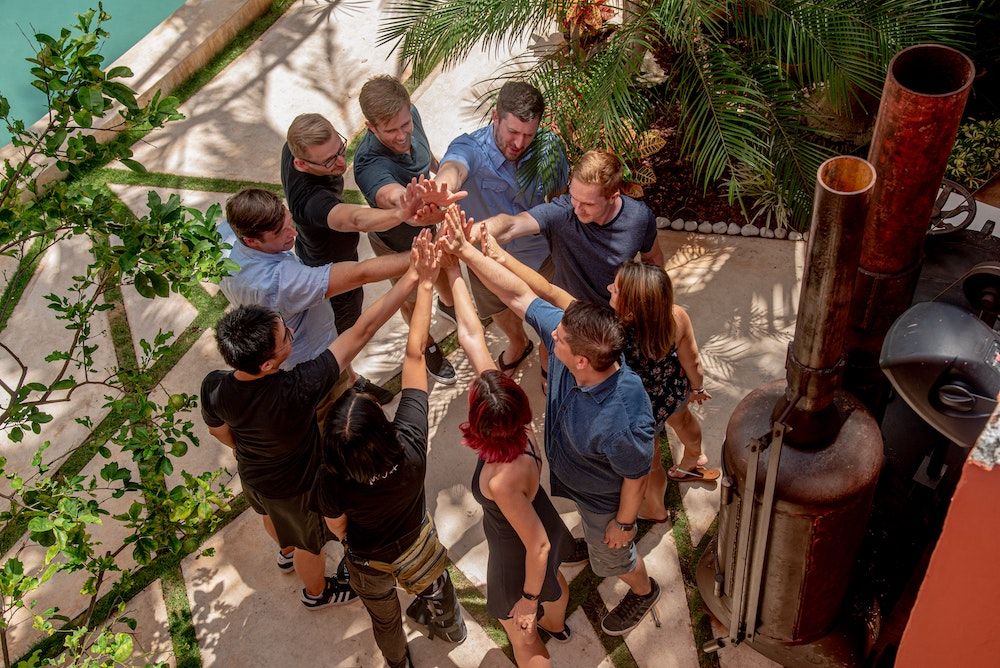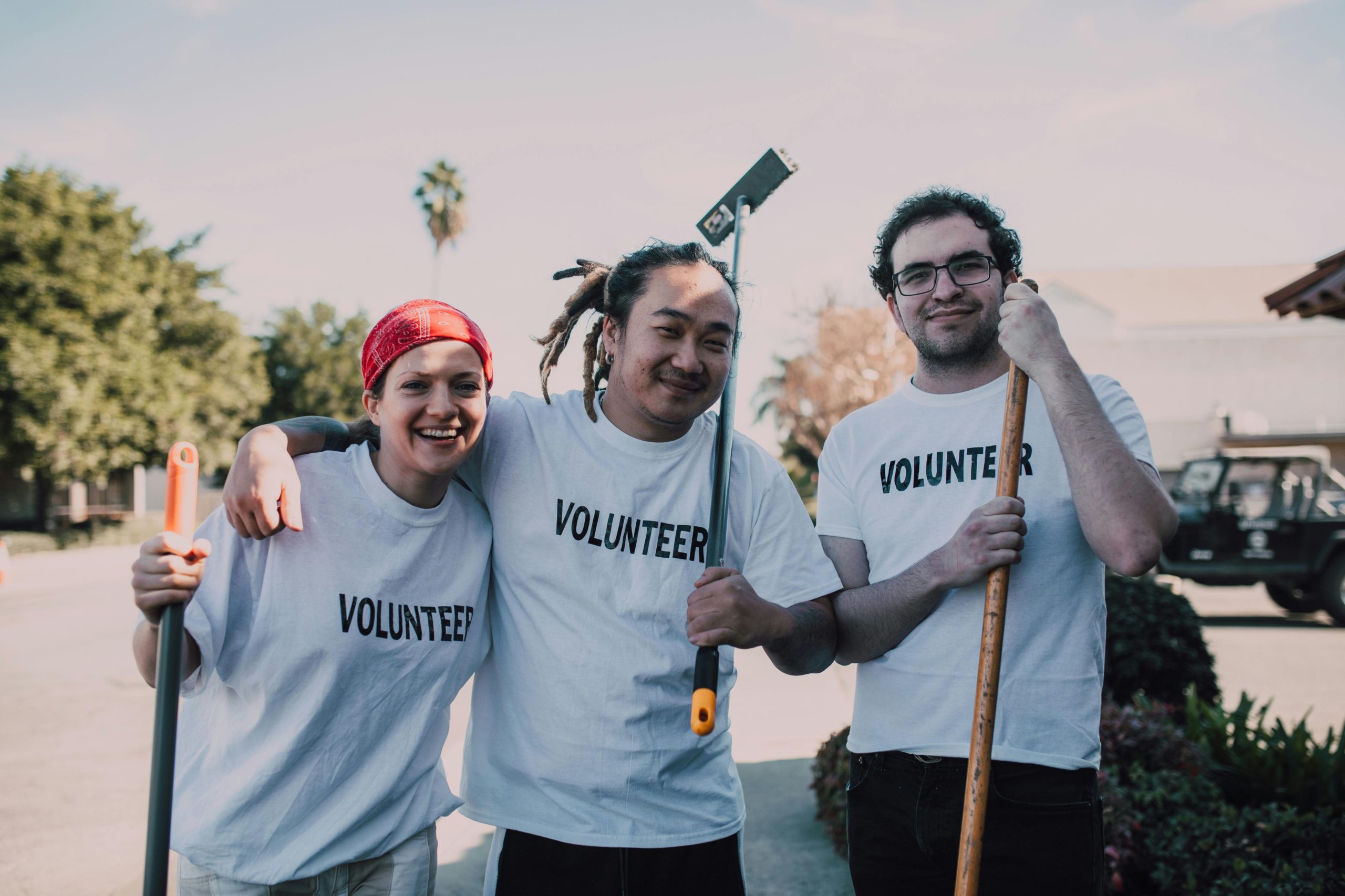Imagine the energy of a crowd, the buzz of collective excitement, and the potential for unforgettable memories.
Yet, coordinating activities for a large group can be as daunting as herding cats, leaving organizers scratching their heads for ideas that truly engage and connect.
Fear not, as large group activities ranging from city tours to charades, and innovative icebreaker templates to conversation cafés, offer myriad ways to foster teamwork, build relationships, and ensure everyone has a blast.
Dive into our Ultimate Guide to Large Group Activities for Any Event, where we’ll uncover a treasure trove of ideas, tips, and resources to make your next large gathering a resounding success.
Understanding the Value of Large Group Activities

When we talk about large group activities, we’re considering events that involve ten or more participants. These activities are crucial because they have the power to engage a whole organization, creating a shared experience that can strengthen team bonds and foster a sense of unity. It’s an opportunity for everyone to be part of something bigger, to feel included, and to contribute to a collective goal, which can be incredibly rewarding and motivating.
Selecting the right activities for large groups is vital because it ensures that every participant feels engaged and valued. The right activity can turn a potentially passive experience into an interactive and memorable one. It’s important to choose activities that:
- Are scalable to accommodate the number of participants
- Offer a variety of roles to suit different preferences and abilities
- Encourage interaction and collaboration among attendees
The significance of large group activities extends beyond just fun and engagement. They are a powerful tool for team building. Through these activities, individuals learn to communicate more effectively, work together towards common goals, and develop a deeper understanding of their colleagues’ strengths and weaknesses. This can lead to improved performance and productivity in the workplace, as well as a more harmonious working environment.
Ultimately, the value of large group activities lies in their ability to create a collective experience that resonates with all participants. When done right, these activities can leave a lasting impression, helping to build a stronger, more cohesive team. They serve as a reminder that, while each individual contributes their unique value, together they can achieve much more than they can alone.
Team Building Activities for Big Groups

Team building activities for big groups are essential tools for enhancing cooperation and communication within a large team. These activities are designed to break down barriers and encourage members to work together to solve problems or complete tasks. By engaging in these group exercises, individuals can learn to appreciate the diverse skills and perspectives that each member brings to the table, fostering a more collaborative and inclusive environment.
The key to successful team building in large groups is to select activities that are flexible and scalable, ensuring that everyone can participate regardless of the group size. Activities should be diverse and engaging, catering to different interests and energy levels. This can range from intellectual challenges to physical competitions, all aiming to strengthen the group’s dynamic and promote a sense of unity.
Whether you’re looking to kick off a conference, inject energy into a corporate retreat, or simply spice up a regular workday, the right team building activities can make all the difference. They should not only be fun but also serve a purpose, such as enhancing communication, building trust, or encouraging creative problem-solving. The goal is to create a memorable experience that translates into better teamwork in the workplace.
Quick Setup Team Building Activities
Quick setup team building activities are the perfect solution for those moments when you need to energize a group quickly or have limited time for a team-building session. These activities are designed to be simple to organize and fast to execute, often requiring minimal or no equipment. They are ideal for impromptu sessions or as icebreakers before larger events.
Some examples of quick setup activities include Copycat, where teams must replicate a structure using office items and a barrier, and Caption This, a game where teams create funny captions for images. These activities typically last between 5 to 20 minutes and are great for:
- Boosting energy levels
- Encouraging creativity
- Improving communication
The beauty of these quick activities lies in their flexibility and adaptability. They can be used in any setting, whether in-person or virtual, and can be scaled to fit the size of your group. From scheduled coffee breaks that foster interpersonal bonding to laser tag that promotes teamwork, these activities are a low-stress way to enhance group dynamics without a significant investment of time or resources.
Elaborate Team Building Challenges

Elaborate team building challenges are an excellent choice for groups looking for a more in-depth team-building experience. These activities require more planning and coordination, but the payoff is a richer, more engaging experience that can have a lasting impact on team dynamics. They often involve complex tasks that stimulate creative thinking, strategic planning, and effective communication.
Activities like Cover Story, where teams design a magazine cover that represents an ideal future for their team, or Engineering Your Team OS, which involves creating an aspirational working system, can take anywhere from one to several hours. They are particularly effective because they:
- Encourage deep reflection on team goals and aspirations
- Foster strategic thinking and problem-solving
- Strengthen bonds through shared challenges
While more elaborate team building challenges require a greater investment of time and effort, they can be highly rewarding. Activities such as Group Timeline and History Map not only improve collaboration but also provide a meaningful examination of the team’s journey and growth. These challenges are best suited for dedicated team building days or retreats where the focus is on developing a cohesive and high-performing team.
Fun Large Group Activities That Everyone Will Love
When it comes to large group activities, nothing beats the universal appeal of fun and laughter. Imagine the energy of a room filled with people all sharing a good chuckle over a comedy show or an improv game. These activities are not just entertaining; they have the power to break the ice and create an atmosphere of camaraderie. Hosting a comedy show is simple: pick a date, find a space, and either hire a comedian or let team members share their best jokes. For a twist, try a virtual comedy show where even remote participants can join in the fun.
Interactive games like ‘What are you doing?’ can spark creativity and have everyone in stitches as they mime and guess each other’s actions. Here are a few reasons why such games are great for large groups:
- They require no special equipment and can be played anywhere
- They’re inclusive, allowing everyone to participate and enjoy
- They often lead to unexpected and hilarious outcomes
For a more unique experience, consider pairing entertainment with a shared interest, such as a Wine + Comedy event. Participants can enjoy a guided wine tasting while a comedian provides the laughs, creating a relaxed environment perfect for networking and team bonding. Such activities are excellent for large groups because they combine a shared sensory experience with humor, making for an engaging and memorable event that everyone will love.
Conference Activities for Large Groups
When planning conference activities for large groups, it’s important to choose options that facilitate networking and keep attendees engaged throughout the event. Activities such as speed networking, where participants have a limited time to introduce themselves and exchange business cards, can be an effective and fun way to ensure that attendees meet a variety of people quickly. Similarly, group challenges that require problem-solving and collaboration can not only break the ice but also promote meaningful connections.
Interactive workshops and seminars are also popular conference activities that can cater to large groups. These sessions can be designed to be educational and interactive, often allowing for group discussions or hands-on activities. For instance, workshops that focus on building specific skills or seminars that explore industry trends can be both informative and engaging. Here are some elements to include:
- Breakout sessions for smaller group discussions
- Interactive polls or quizzes to keep the energy high
- Group projects that culminate in a presentation or demonstration
Lastly, incorporating technology can take conference activities to the next level. Utilizing apps or platforms for live polling, Q&A sessions, or virtual networking rooms can enhance interaction, especially in large settings. Social media challenges, where attendees post about the conference or engage in activities using a specific hashtag, can also add an element of fun and encourage participation. These tech-driven activities can help maintain a dynamic and connected atmosphere, ensuring that the conference remains a memorable experience for all.
Bonding Activities for Large Groups to Foster Team Spirit
Bonding activities are essential in creating a strong team spirit within large groups. They are designed to break down barriers and encourage open communication, which is the foundation of any successful team. Activities that involve sharing personal stories, like ‘Two Truths and a Lie’, allow team members to learn more about each other in a fun and engaging way. Trust-building exercises, such as blindfolded obstacle courses, require team members to rely on each other’s guidance, strengthening their trust and cooperation.
Another effective way to foster team spirit is through competitive yet friendly activities. Games like tug-of-war, relay races, or scavenger hunts create a sense of unity as team members work towards a common goal. These activities can be particularly beneficial as they:
- Encourage healthy competition
- Increase group cohesion
- Provide an opportunity for everyone to contribute to the team’s success
For a more relaxed bonding experience, consider activities that focus on collective creativity or shared interests. Group art projects, where each member contributes to a large canvas, or joint musical endeavors, like forming a drum circle, can be incredibly unifying. These activities not only spark creativity but also allow team members to connect on a deeper level, as they collaborate on a project that reflects their collective effort and vision.
Easy and Engaging Large Group Team Games
When organizing games for large groups, it’s essential to pick activities that are easy to learn and quick to start. This ensures that everyone can join in without lengthy explanations or setup times. Games like “Apple, Orange and Banana!” are perfect for this situation. Participants simply form a circle and follow simple commands like jumping forward for ‘apple’, backward for ‘orange’, and turning around for ‘banana’. It’s a game that gets everyone moving and laughing in no time, making it an ideal icebreaker for any large group setting.
Another game that fits the bill is “Bang!”, where quick reactions are key. Players form a circle with one person in the center acting as the ‘sheriff’. The sheriff points at players who must duck promptly while their neighbors ‘draw’ to avoid being ‘shot’. This game is great because:
- It requires no special equipment
- It’s fast-paced and energizing
- It helps with learning names in new groups
For a game that combines fun with creative thinking, “What are you doing?” is an excellent choice. A volunteer performs a mime, and others guess what it is, then the mime changes to a new action given by a player. This game is especially engaging because it:
- Encourages creativity and improvisation
- Is suitable for all ages
- Often results in unexpected and amusing scenarios By choosing games like these, organizers can ensure that their large group activities are inclusive, dynamic, and enjoyable for everyone involved.
Keeping a Large Group Entertained: Tips and Tricks
Keeping a large group entertained is all about finding the right balance between structure and spontaneity. You want to have a planned itinerary that includes diverse activities catering to different interests, but also leave room for impromptu fun. For example, you might schedule a talent show or a group trivia game, but also have a dance floor ready for those who just want to let loose. Here’s how you can set the stage for a fun event:
- Schedule structured activities like team competitions or performances
- Provide opportunities for free play, such as a dance area or open mic
- Ensure there’s a variety of activities to cater to different preferences
When you’re dealing with a large number of people, it’s important to encourage participation without making anyone feel pressured. Interactive games that people can join at their own pace are perfect for this. Consider setting up stations for activities like ring toss, giant Jenga, or photo booths. These can be great because:
- They allow individuals to engage at their own comfort level
- No one feels singled out, as participation is voluntary
- Groups can form organically, fostering natural social interactions
Lastly, don’t underestimate the power of shared experiences to bring people together. Activities that require group cooperation, such as building a large puzzle or creating a group mural, can be powerful in creating a sense of community. Remember to:
- Choose activities that require collaboration, enhancing the sense of team
- Encourage everyone to contribute, regardless of skill level
- Celebrate the completed project as a collective achievement, which can be a highlight of the event
Tailored Activities for Groups of 15, 20, or 30 People
Organizing activities for groups of 15, 20, or 30 people requires a thoughtful approach to ensure everyone is involved and having fun. For a group of 15, consider activities that promote close interaction and teamwork, such as a cooking class where everyone can participate in creating a meal. With 20 participants, a mini-Olympics with various sports stations can keep the energy high and encourage friendly competition. For a larger group of 30, a murder mystery dinner can be an exciting way to engage everyone in a collaborative and immersive experience.
Each group size presents unique opportunities for tailored activities. Here are some ideas for each:
- For 15 people: A scavenger hunt around the office or local area, which fosters teamwork and problem-solving.
- For 20 people: “Human Knot”, a game where participants must untangle themselves without letting go of each other’s hands, promoting communication and cooperation.
- For 30 people: “Group Juggle”, where team members toss balls to each other in a specific order, enhancing focus and collaboration.
When planning activities for these group sizes, remember to keep the activities simple to understand and quick to start. This ensures that everyone can join in the fun without needing extensive instructions. Also, consider the space available and how it can best be used to accommodate your group. Whether it’s a spacious outdoor area for a relay race or a cozy conference room for a strategy game, choosing the right environment can greatly enhance the experience for your group.
Creative and Unique Large Group Activity Ideas
For a truly memorable event, creative and unique activities are key. Take puzzle games, for instance; they can range from a Sherlock Holmes-style crime-solving adventure to an orienteering challenge that combines fitness with fun. Escape games, where teams work together to find their way out of a locked room by solving clues, have become incredibly popular and can be tailored for both kids and adults. These activities not only provide excitement but also encourage critical thinking and teamwork.
If you’re looking to infuse some artistic flair into your event, consider a Food Art Exhibit or a DIY Crafting Challenge Fest. Food art exhibits allow participants to appreciate the aesthetic side of cuisine, turning edible items into impressive sculptures. On the other hand, a crafting challenge can engage attendees in creating everything from clay sculptures to paper crafts, potentially even raising funds by selling the crafted items. Such activities allow participants to:
- Showcase their creativity
- Work together in new and interesting ways
- Take home a tangible reminder of the event
For those with a competitive streak, organize a Team Sporting Day with popular games like football or basketball to ignite the inner competitor in everyone. Alternatively, an Innovative Gift Exchanging Event can add a personal touch, where friends express appreciation through letters, potentially stirring deep emotions. These activities not only provide enjoyment but also:
- Foster a sense of community
- Offer a platform for personal expression
- Create an opportunity for emotional bonding
The Benefits of Team Building for Large Groups

Team building activities are a powerhouse for enhancing communication within large groups. They provide a platform for dialogue that might not occur in a typical office setting. By engaging in fun and challenging tasks, team members are encouraged to speak up and share ideas. This improved communication can lead to:
- Better understanding among colleagues
- More effective collaboration on projects
- A stronger sense of community within the group
Collaboration is another significant benefit of team building activities. When large groups come together to solve problems or complete tasks, they learn to pool their resources and leverage each other’s strengths. This collaborative spirit extends beyond the activity itself, fostering a culture of teamwork in the workplace. Team building activities can help to:
- Identify individual team members’ unique skills
- Create an environment where everyone feels valued
- Enhance the group’s ability to work together towards common goals
Lastly, team building activities are fantastic morale boosters. Participating in these events can give employees a break from the routine, making them feel appreciated and cared for. A boost in morale often translates to:
- Increased job satisfaction
- Higher levels of engagement
- Greater overall productivity By incorporating team building activities into large group events, organizations can create a more dynamic and cohesive workforce.
Planning Large Group Activities: A Step-by-Step Guide
Planning large group activities requires careful consideration and a step-by-step approach to ensure success. Start by assessing your group’s size and dynamics, which will influence the type of activities you choose. For instance, a group of creative professionals might enjoy an improvisational workshop, while a sports team may prefer a high-energy competition. Understanding the group’s composition is key to selecting activities that will resonate and engage.
Next, secure a venue that accommodates your group comfortably. Remember to never underestimate the space you’ll need. Consider factors like:
- Meeting and breakout spaces for different activities
- Ease of access for all participants
- Availability of necessary facilities, such as audio/visual equipment Choosing the right venue can greatly impact the structure and success of your event, so take the time to find a place that suits your needs.
Timing is crucial when planning large group activities. Start mapping out details as early as possible to secure top-notch facilitators and ideal meeting spaces. Keep in mind that coordinating schedules for a large number of participants can be challenging, so the earlier you begin, the better. Also, plan for unexpected changes in participant count by preparing for at least 10% more attendees than expected, ensuring you won’t be caught off guard.
Lastly, be prepared to be flexible. Large-group events can be unpredictable with many moving parts. Use your event’s objectives to guide you through any obstacles and changes. Stay calm and adaptable, and if certain aspects can’t be changed, communicate clearly with your venue or service providers who will often be willing to help. By staying organized and maintaining a positive attitude, you’ll navigate the planning process successfully and create an enjoyable experience for everyone involved.
Managing Logistics for Large Group Events
Managing logistics for large group events can often feel like a complex puzzle, with many pieces needing to fit together perfectly. It’s about ensuring that every detail is accounted for, from transportation and accommodation to food and activity scheduling. For instance, ensuring there’s enough seating for all, meals are served promptly, and activities start on time are just a few of the logistical details that require attention.
To streamline the process, consider these strategies:
- Partner with reliable vendors who can handle large orders and have experience with big events.
- Use technology to your advantage, such as event management software for scheduling and attendee tracking.
- Plan for contingencies, like bad weather or last-minute cancellations, to avoid disruptions.
Communication is also a cornerstone of successful event logistics. Keep everyone informed by:
- Sending regular updates to attendees about the schedule and any changes.
- Designating team leaders for different aspects of the event to ensure smooth operations.
- Having a clear point of contact for questions and concerns helps prevent confusion and ensures that issues are dealt with promptly.
Adapting Activities for Various Environments
Whether you’re planning activities for an indoor conference room, a spacious outdoor park, or a digital platform, adapting to your environment is key to a successful large group event. For indoor settings, consider transforming areas like a block space into a venue for group activities by using sheets to cover shelves or rearranging furniture to create more room. In outdoor environments, activities like geocaching or yoga challenges can be seamlessly integrated with the natural surroundings to enhance the experience.
Virtual environments also offer unique opportunities for large group activities. Utilize digital tools like video conferencing to host interactive games or workshops that encourage participation from all attendees. Here are some ideas for adapting activities to a virtual setting:
- Online scavenger hunts where participants find items in their home or online
- Virtual escape rooms that challenge teams to solve puzzles together
- Live-streamed performances or shows that allow for audience interaction
No matter the environment, it’s important to ensure that each activity is accessible and enjoyable for all participants. In indoor and outdoor settings, make sure there’s adequate space for everyone to participate comfortably. For virtual events, check that all participants have the necessary technology and a stable internet connection. By considering these factors, you can adapt any activity to fit your environment and create an engaging experience for your large group.
Resources for More Large Group Activity Ideas
Finding fresh and engaging ideas for large group activities can sometimes be a challenge, but fortunately, there are plenty of resources available to help you out. From books to websites, there’s a wealth of knowledge just waiting to be tapped into. For those who love to have a physical reference on hand, there are books dedicated to group games and team-building exercises, filled with step-by-step instructions and tips for successful implementation.
The internet is also brimming with websites that specialize in large group activities. These online platforms offer a diverse range of options, from printable icebreaker templates to interactive workshop guides. Here’s a quick list of resources that you can explore for more ideas:
- Online libraries with a vast collection of facilitation techniques
- Websites featuring creative toolkits for group activities
- Platforms that provide free resources and guides for team-building exercises
In addition to books and websites, several organizations offer workshops and training sessions focused on large group dynamics and activities. These can be particularly helpful for those looking to deepen their understanding of group facilitation or to find new and innovative activities. Whether you’re planning a corporate event or a casual get-together, these resources can provide the inspiration and guidance needed to make your large group activity a resounding success.
Measuring the Success of Your Large Group Activities
Measuring the success of large group activities is crucial to understanding their impact and ensuring they meet your objectives. Whether you’re aiming to enhance team communication, boost morale, or integrate new members, it’s important to establish clear goals before the event. Afterward, gather quantitative data such as participation rates or qualitative feedback through surveys to gauge the activity’s effectiveness.
Several methods can be employed to measure success effectively. Consider these approaches:
- Ask for direct feedback from participants through surveys or discussions to get personal insights.
- Observe changes in team dynamics or performance metrics post-activity, which could indicate a positive shift.
- Compare the outcomes against pre-established benchmarks or past events to measure progress or improvement.
Ultimately, the success of large group activities is reflected in the long-term benefits they bring to the team. Look for signs of improved collaboration, increased engagement, and a stronger team spirit. Remember, the true value of these activities often goes beyond immediate results, fostering a culture of unity and continuous improvement within the group.
Latest Trends in Large Group Activities
The landscape of large group activities is constantly evolving, with new trends emerging that cater to the changing dynamics of teams and organizations. One of the most significant trends is the integration of technology, which has given rise to virtual and hybrid events. These events combine in-person interactions with digital elements, allowing participants who can’t be physically present to still take part in the activities. For example, hybrid scavenger hunts use apps to guide participants, blending the physical thrill of the hunt with digital convenience.
Another trend gaining traction is the focus on activities with a positive impact, such as environmental clean-ups or charity fundraisers. These activities not only serve as team-building exercises but also contribute to the well-being of the community and the environment. Teams can engage in efforts like:
- Organizing a river cleanup
- Participating in a charity run
- Building structures for community use
Lastly, there’s a growing preference for active and outdoor activities that break the monotony of office life and promote health and wellness. These activities range from adventure trails to team sports, providing a refreshing change of scenery and an adrenaline boost. Outdoor activities like orienteering or beach Olympics encourage teams to collaborate in new settings, fostering stronger connections and creating lasting memories.
Do’s and Don’ts of Large Group Activities
When planning activities for large groups, it’s crucial to keep in mind the do’s and don’ts that can make or break the experience. Do ensure that activities are inclusive and can be enjoyed by all, regardless of physical ability or background. Safety should always be a top priority, so don’t forget to have first aid available and to plan for any potential risks associated with your activities.
Here are some key do’s to remember:
- Do use icebreakers to help everyone feel comfortable and connected.
- Do provide clear instructions and demonstrations to avoid confusion.
- Do encourage participation, but never force anyone to join in if they’re uncomfortable. On the flip side, here are some don’ts to avoid:
- Don’t let the loudest voices dominate; ensure everyone has a chance to contribute.
- Don’t overlook the importance of breaks; keep the schedule relaxed enough to prevent fatigue.
Lastly, do seek feedback after the activities to learn what worked and what didn’t, as this can help improve future events. Don’t underestimate the power of a well-timed debrief; it can reinforce the positive outcomes and lessons learned during the activities. By following these do’s and don’ts, you’re more likely to create a fun, engaging, and memorable experience for all participants.
Elevate Your Group Experience with INDULGE’s Culinary Adventures
Imagine the thrill of discovering Zurich’s hidden culinary gems with INDULGE’s expertly crafted food tours. These tours are more than just a chance to taste exquisite flavors; they’re an opportunity to connect with colleagues and forge new friendships. INDULGE’s local chefs, sommeliers, and bartenders guide you through Zurich’s vibrant food scene, sharing stories and insights that turn a simple meal into a shared adventure.
INDULGE’s offerings are perfectly suited for large groups looking to combine fun with a cultural deep dive. Participants can enjoy a variety of benefits, including:
- Exploring Zurich West’s international food scene or Old Town’s Swiss classics
- Exclusive Wine & Dine experiences in Zurich’s industrial heart
- Curated tours that offer a blend of history, culture, and delicious tastings
To elevate your next group event with an unforgettable culinary journey, visit INDULGE’s website. Whether you’re planning a team-building activity, a corporate event, or a special celebration, INDULGE’s culinary adventures are designed to leave a lasting impression. Book a tour and get ready to create memories that will linger as long as the exquisite tastes you’ll discover.
Frequently Asked Questions
How do you keep a large group entertained?
Keeping a large group entertained involves finding the right balance between structured activities and the opportunity for spontaneous fun. It’s important to plan a variety of activities that cater to different interests and allow for free play. Encouraging voluntary participation in interactive games that individuals can join at their own pace is also key. Additionally, providing shared experiences that require group cooperation, such as building a large puzzle or creating a group mural, can create a sense of community and keep everyone engaged.
What to do with 30 people?
For a group of 30 people, a murder mystery dinner can be an engaging and collaborative experience. Other activities suitable for this group size include a “Group Juggle” game, where team members toss balls to each other in a specific order to enhance focus and collaboration, or a mini-Olympics with various sports stations to encourage friendly competition and group cohesion.
What to do with 15 people?
For a group of 15 people, consider activities that promote close interaction and teamwork, such as a cooking class where everyone can participate in creating a meal. A scavenger hunt around the office or local area can also be a fun and engaging activity that fosters teamwork and problem-solving skills.
What to do for 20 people?
For a group of 20 people, organizing a “Human Knot” game, where participants must untangle themselves without letting go of each other’s hands, can promote communication and cooperation. A mini-Olympics with various sports stations can also be a great activity to keep the energy high and encourage friendly competition among the participants.








